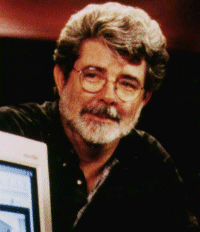For those of us who are loyal Star Wars fans, George Lucas may be seen as near and dear to our hearts. Even if you aren't into
Star Wars, Indiana Jones or
American Graffiti, George Lucas is still a notable filmmaker within the realm of cinema. In the
Edutopia article
"Life on the Screen; Visual Literacy in Education," written by James Daly, Lucas comments on his thoughts about America's changing literacy skills. As a man who is considered to have a creative mind and who values the changing mediums with which we communicate today (film, television, web), Lucas offers his take on what the American education system needs to do to connect better with students, and encourage more visual literacy and communication skills, skills that are more applicable to our current world and students' lives.
George Lucas explains that he was "an average student who daydreamed a lot," a description that might describe many of the students in our education system today. Perhaps it wasn't that Lucas was uninterested in the things he was being taught, rather, he was uninterested in the
way in which such things were taught. This memory of his past has inspired Lucas to promote a new way of learning that emphasizes students' need to succeed in a visual, digital world. Today's students are used to a faster-paced society, and so they are more interested in learning things when they are made more relevant to the things they know. "They need to understand a new language of expression," says Lucas, which means that students want to be taught in such a way that they are using today's tools, rather than antiquated styles of learning.
Mr. Lucas thinks there is a lot of change on the horizon. Today, the language of visual literacy has become more prominent and necessary, because or society has created a visual culture that needs to be learned about in order to be perpetuated and utilized effectively. We have so much contained within the visual culture that to not teach about and expose students to an understanding of visual literacy would be extremely unwise. Lucas remarks "We must teach communication comprehensively, in all its forms. Today we work with the written or spoken word as the primary form of communication. But we also need to understand the importance of graphics, music, and cinema, which are just as powerful and in some ways more deeply intertwined with young people's culture. We live and work in a visually sophisticated world, so we must be sophisticated in using all the forms of communication, not just the written word." I think Lucas really hits the nail on the head (to use a silly cliche) when he comments upon how we need to teach communication in relation to visual literacy. You see so many people who want to make effective presentations and get their points across effectively, in school and business settings, and often times they are very clueless in terms of what an effective presentation (using visual elements) must contain.
In terms of the future, I think that we need to take Lucas's words to heart, and really reconsider how we're approaching the development of our visual literacy, both inside the classroom and out. Do we learn more about visual literacy from our daily lives? For now I think we do, but that may be subject to change in the coming years. If Lucas's hopes are fulfilled, we're going to have to start trying harder. "Nothing is accomplished through conquest. Everything is accomplished through education," (George Lucas, 2004).


No comments:
Post a Comment